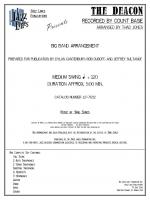DEACON, THE
Recorded by the Count Basie Orchestra
Arranged by Thad Jones, Prepared by Dylan Canterbury, Rob DuBoff, and Jeffrey Sultanof

Cat #: JLP-7632
$65.00This item usually ships within 1 business day.
Questions?
Please call +1-518-587-1102 or email us.
Edition: Jazz Big Band Arrangement
Description: Swing - Medium Difficult
Publisher: Jazz Lines Publications
In many ways The Deacon serves as a preview of what was to come from the pen of Thad Jones in the 1960s. Several devices he employs here (e.g. some crunchy voicings, syncopated brass breaks, and sustained tones underneath a shout section) would all go on to pop-up in some of his most famous works of that decade, but made their first appearance in this 1959 arrangement for the Count Basie Orchestra.
As is the regular case with Basie charts, things begin with a piano solo - four bars unaccompanied, followed by a single blues chorus with the rest of the rhythm section. The melody proper begins at measure 17 with a gospel-influenced melody and an irresistibly catchy groove laid down by drummer Sonny Payne. Some occasional "amens" from the saxes fill in the gaps, but the main star of this segment is the brass section. Take particular note of their delightful four bar double-time break at measure 29.
Things shift over to a soloist-oriented mode beginning at measure 41. Basie gets a chorus to start things off, followed by Jones's trumpet for two choruses beginning at 53, then Al Grey's plunger muted trombone for two choruses beginning at measure 77. Each horn player has a different set of backgrounds underneath their first chorus. For the trumpet solo, it's a series of disjointed horn stabs; for the trombone solo, it's moaning saxes that bear more than a slight resemblance to the sounds you'd hear at an old-time revival meeting.
The trumpet solo backgrounds return at measure 101. This time, they are underpinned by a sustained F that carries throughout the chorus. This note is passed around between the brass players, but should sound as close to a single player as possible. The intensity slowly builds during this part until the deacon's sermon reaches its energetic climax at measure 113, with the brass delivering the good news to a congregation of cheering saxes. A two-bar bass break brings the initial theme back at measure 125. Unlike before, the theme is slightly condensed into 8 bars, with everything gradually winding down to a gentle conclusion.
This publication was based on the set of parts used during the recording session - this is not a transcription.
2 Alto Saxophones
2 Tenor Saxophones
Baritone Saxophone
4 Trumpets
3 Trombones
Guitar
Piano
Bass
Drums
Trombone 1: Ab4










